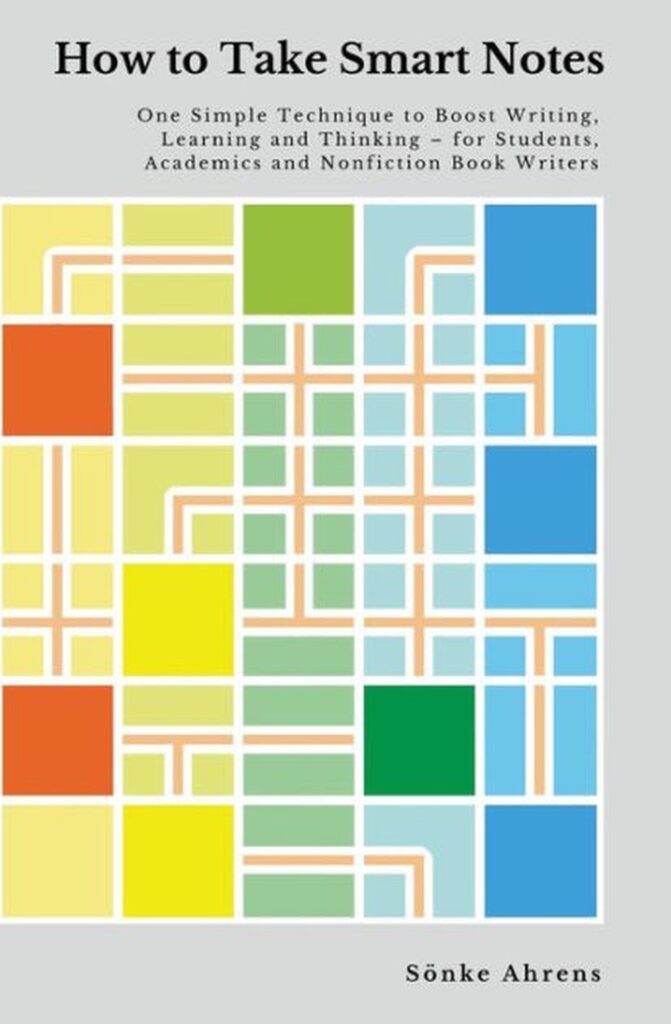Sharing my learnings from the book, How to Take Smart Notes by Sönke Ahrens
How to Take Smart Notes by Sönke Ahrens
The key to good and efficient writing lies in the intelligent organisation of ideas and notes. This book helps students, academics and nonfiction writers to get more done, write intelligent texts and learn for the long run. It teaches you how to take smart notes and ensure they bring you and your projects forward.
The Take Smart Notes principle is based on established psychological insight and draws from a tried and tested note-taking-technique. This is the first comprehensive guide and description of this system in English, and not only does it explain how it works, but also why. It suits students and academics in the social sciences and humanities, nonfiction writers and others who are in the business of reading, thinking and writing.
Instead of wasting your time searching for notes, quotes or references, you can focus on what really counts: thinking, understanding and developing new ideas in writing. It does not matter if you prefer taking notes with pen and paper or on a computer, be it Windows, Mac or Linux. And you can start right away.

- Luhmann was a German man who, in the 1960s, worked in an administration office. His leisure-time passion was reading. As he read, he made notes on things that interested him – philosophy, organizational theory, sociology. He made these notes on small pieces of paper, which he then systematically numbered before filing them in a Zettelkasten, or slip-box. Eventually, he put some of his thoughts into a paper and presented it to an influential German sociologist. Impressed, the sociologist invited Luhmann to become a professor of sociology at the University of Bielefeld.
- Many people regarded Luhmann as a genius. But studies of his methods show that his success wasn’t the result of an inordinately vast intelligence. It was the result of smart working. Luhmann knew exactly how to use his notes, which allowed him to remain focused and in control.
- Luhmann had two slip-boxes.
- One was for collecting references and his notes on the contents of books.
- The other, his main slip-box, was for storing notes and ideas.
- Systematically make three types of notes to develop your ideas and arguments
- fleeting notes. Fleeting notes don’t go in a slip-box; they’re simply for capturing ideas and thoughts.
- literature notes – notes about what you read. While you’re reading, write down things you don’t want to forget along with reference details.
- permanent notes. These will arise from your fleeting and literature notes, which you should go through regularly – preferably daily. As you review your notes, ask yourself what’s relevant to your own ideas, your research, and your interests.
- Write one permanent note for each idea using full sentences in your own words. The aim is not to copy; it’s to create something new. Be as precise and concise as you can, and don’t forget to include your sources. You can throw away your fleeting notes after you’ve made permanent ones.
- File your new permanent notes in your slip-box behind one or more existing notes.
- The final element in the system is your index – keywords with a link to an entry point to particular subjects in your slip-box.
- Luhmann didn’t file his notes by subject. Rather, he used an abstract numbering system. Each note had a unique identifier made up of numbers and letters.
- if you’ve been populating your slip-box, you can use the information you already have to develop your research. Ask yourself what’s missing, and then read more to fill in any gaps. Clusters of ideas and thoughts in your slip-box may help you decide what to write about. Then, collect all your relevant notes and connections, and copy them to your desktop. Ask yourself if there are any holes in your arguments. If there are, then you need to either fill them or change tack. Finally, you can edit and proofread your paper. After that, you’re ready for the next one!
- Writing your permanent notes also acts as a kind of self-test. Consider whether your thoughts still make sense when you write them down
- When you write down your thoughts, you also distance yourself from them, which allows you to think more critically about your arguments.
- Read with a pen in your hand.
- Your ideas and thoughts will develop as you read more. And your slip-box, as it begins to fill with permanent notes, will itself become a treasure trove of ideas. It’ll stimulate your thoughts, and you’ll be challenged by the connections it presents.
- While reading and note-taking, you also need to be aware of your confirmation bias. Make a conscious effort to not only seek out arguments that confirm your current views or what you know already.
- when you’re writing your permanent notes, you’re doing so for someone who may have general knowledge in the field, but perhaps doesn’t know the specifics and the original context. And that person . . . is your future self
- Your slip-box enhances your learning through elaboration. Elaboration is when you think about the meaning of what you’re reading and how it relates to your own thoughts, ideas, and arguments. You automatically start to reflect deeply on what you’ve read. And this is what facilitates real learning.
- With your slip-box, your learning is enhanced because as it evolves, you evolve, too. As you purposefully build connections between notes, you build those very same connections in your head. And that web of knowledge, theories, and ideas gives you hooks on which to hang the next piece of information or argument, and so on. Each time you access information from your slip-box to connect new notes, you elaborate connections further, which creates a virtuous circle of learning.


Leave a Reply